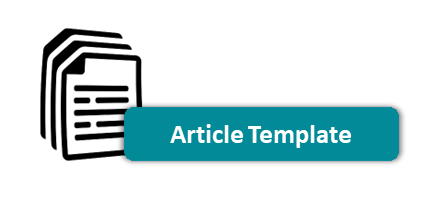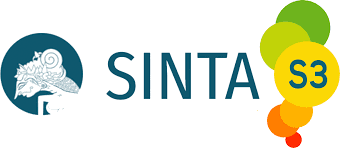PENGARUH PAPARAN MEDIA SOSIAL TERHADAP NIAT MENGUNJUNGI DESTINASI WISATA (STUDI PADA STUDIO ALAM GAMPLONG)
DOI:
https://doi.org/10.24002/modus.v32i2.3530Abstract
ABSTRACTThis study examines how the influence of social media exposure in shaping the behavior of tourists visiting the destination. The destination referred to in this study is a film tourism destination such as Studio Alam Gamplong and also how it affects the desires and gratification of destination content. Questionnaires were distributed as many as 202, but the number of samples used in this study were 173 respondents, respondents who had access to information about the Bumi Manusia and knew the Studio Alam Gamplong as the shooting location. The results of the study note that exposure to social media affects the intention to visit tourist destinations through the desire to travel and gratification of destination content, as well as the direct effect between social media exposure on the intention to visit tourist destinations. In addition, the mediation test results in a complementary and partial mediation model that can influence between independent variables on the dependent variable in the model both directly and indirectly. The desire to travel is an important variable in this study in formulating the intention of visiting tourists to the Studio Alam Gamplong.
Keywords: social media exposure; desire to travel to destination; gratification destination content; intention to visit destination
ABSTRAK
Penelitian ini melihat bagaimana pengaruh paparan media sosial dalam membentuk perilaku wisatawan yang mengunjungi destinasi wisata. Destinasi wisata yang diteliti pada penelitian ini adalah destinasi wisata film seperti Studio Alam Gamplong dan pengaruhnya terhadap keinginan dan gratifikasi konten destinasi. Kuesioner yang dibagikan berjumlah 202, namun sampel dalam penelitian ini berjumlah 173 responden, yaitu para responden yang memiliki akses informasi tentang film Bumi Manusia dan mengetahui Studio Alam Gamplong sebagai tempat syuting film. Hasil penelitian ini menunjukkan bahwa paparan media sosial mempengaruhi niat mengunjungi destinasi wisata melalui keinginan untuk melakukan perjalanan dan gratifikasi konten destinasi, serta terdapat pengaruh langsung paparan media sosial pada niat mengunjungi destinasi wisata. Selain itu, hasil pengujian mediasi menunjukkan model mediasi komplementer dan parsial yang mempengaruhi hubungan antara variabel independen dan variabel dependen baik secara langsung maupun tidak langsung. Keinginan melakukan perjalanan merupakan variabel yang penting dalam penelitian ini di dalam merumuskan niat mengunjungi destinasi wisata Studio Alam Gamplong.
Kata kunci: paparan media sosial; keinginan melakukan perjalanan; gratifikasi konten destinasi; niat mengunjungi destinasi
References
Arifin, P. (2013) Persaingan Tujuh Portal Berita Online Indonesia berdasarkan Analisis Uses and Gratifications, Vol. 10 No. 2, pp 195-212.
Baron, R. M., & Kenny, D. A. (1986). The moderator–mediator variable distinction in social psychological research: Conceptual, strategic, and statistical considerations. Journal of Personality and Social Psychology, 51(6), 1173–1182. doi:10.1037/0022-3514.51.6.1173
Chen, Y. C., Shang, R. A. & Li, M. J. (2014), The effects of perceived relevance of travel blogs’ content on the behavioral intention to visit a tourist destination, Computers in Human Behavior, Vol. 30, pp. 787-799.
Di Pietro, L., Di Virgilio, F., & Pantano, E. (2012). Social network for the choice of tourist destination: attitude and behavioural intention. Journal of Hospitality and Tourism Technology, 3(1), 60– 76. doi:10.1108/17579881211206543.
Doosti, S., Mohammad, R. J., Ali, A., Javad, K. P., Parisa, M. A. (2016), Analyzing the influence of electronic word of mouth on visit intention: the mediating role of tourists’ attitude and city image, International Tourism, Vol. 2 No. 2, pp. 137-148.
Fu, H., Ben, H. Y., & Junzhi, X. (2016). Reality TV, audience travel intentions, and destination image, Tourism Management, Vol. 55, pp. 37-48.
Ghozali, I & Hengky, L., (2015). Konsep, Teknik, Aplikasi Menggunakan Smart PLS 3.0 Untuk Penelitian Empiris. BP Undip. Semarang.
Hidayat, A. & Robert, L. A. (2018). The Impact Of Social Media As Promotion Tools Towards Intention To Visit: Case Of Batu, Malang, Indonesia. Business and Management Research (AEBMR), 52, 60-71.
Ho, K. K. W., & See-To, E. W. K. (2018). The impact of the uses and gratifications of tourist attraction fan page. Internet Research, 28(3), 587–603.
Hunter, G. L. (2006). The role of anticipated emotion, desire, and intention in the relationship between image and shopping center visits. International Journal of Retail & Distribution Management, 34(10), 709–721. doi:10.1108/09590550610691310.
Hur, K., Taegoo, T. K., Osman, M. K., & Gyehee, L. (2017), An exploration of the factors influencing social media continuance usage and information sharing intentions among Korean travellers, Tourism Management, Vol. 63 pp 170-178.
Kim, S. (2012), Audience involvement and film tourism experiences: Emotional places, emotional experiences, Tourism Management, Vol. 33 No. 2, pp. 387-396.
Kim, S., Son, Y.J.,Tian, Y., Chiu, Y.C & Yang, C.Y.D. (2014), Hierarchical En-Route Planning under the Extended Belief-Desire-Intention (E-BDI) Framework, IIE Annual Conference. Norcross, pp. 547-556.
Kiráľová, A., & Antonín, P. (2015). Development of Social Media Strategies in Tourism Destination. Social and Behavioral Sciences, 175 ( 2015 ) 358 – 366.
Koo, C., Joun, Y., Han, H., & Chung, N. (2016). A structural model for destination travel intention as a media exposure. International Journal of Contemporary Hospitality Management, 28(7), 1338–1360.
Koo, C., Namho, C., Dan, J. K., dan Sunyoung, H. (2016). The impact of destination websites and cultural exposure: a comparison study of experienced and inexperienced travelers, International Journal of Tourism Cities, Vol. 2 No. 1, pp. 1-16.
Llodra-Riera, I., Martínez-Ruiz, M. P., Jimenez-Zarco, A. I., & Izquierdo- Yusta, A. (2015). A multidimensional analysis of the information sources construct and its relevance for destination image formation. Tourism Management, 48, 319-328.
Molinillo, S., Francisco, L. C., Rafael, A.S. & Dimitrios, B. (2018), DMO online platforms: Image and intention to visit, Tourism Management, Vol. 65 pp. 116-130.
Noviandi, F., (2018). “Mengenal desa wisata gamplong, tempat syuting bumi manusia”, Suara.com, 25 Mei 2018 diakses dari https://www.suara.com/lifestyle/20 18/05/25/170148/mengenal-desa-wisata-gamplong-tempat-syuting-bumi-manusia pada tanggal 19 September 2019.
Omarjee, L., & Chiliya, N. (2014). The Effectiveness of Product Placement in Music Videos: A Study on the Promotion Strategies for Brands and Products to Target the Y Generation in Johannesburg. School of Economics and Business, University of Witwatersrand.
Parra-López, E., Bulchand-Gidumal, J., Gutiérrez-Taño, D., & Díaz-Armas, R. (2011). Intentions to use social media in organizing and taking vacation trips. Computers in Human Behavior, 27(2), 640–654. doi:10.1016/j.chb.2010.05.022.
Pertiwi, W.N dan Nistanto, R.K. (2019). Separuh Penduduk Indonesia Sudah "Melek" Media Sosial, Kompas. com, 4 Februari 2019 diakses dari https://tekno.kompas.com/read/201 9/02/04/19140037/separuh-penduduk-indonesia-sudah-melek-media-sosial pada tanggal 18 September 2019.
Prasetya, C.H.A., Kumadji, S., & Yulianto, E. (2014). Pengaruh citra merek, kualitas produk terhadap kepercayaan serta keputusan pembelian, Jurnal Administrasi Bisnis (JAB), Vol. 15 No. 2, pp. 1-6.
Quintal, V & Ian, P. (2015), The role of movie images and its impact on destination choice, Tourism Review, Vol. 70 Iss 2 pp. 97 – 115.
Riptiono, S., (2017). Hasrat konsumen yang mengikat (biding customer desires). Jurnal Fokus Bisnis, Vol.16, No.02, 82-92.
Riyanto, A.D., (2019), “Hootsuite (We are Social): Indonesian Digital Report 2019”, Hootsuit, 9 Februari 2019 diakses dari https://andi.link/hootsuite-we-are-social-indonesian-digital-report-2019/ pada tanggal 4 Juli 2019.
Sekaran, U & Roger, B., (2016). Research Methods for Business, Seventh Ed. United Kingdom: John Wiley & Sons Ltd.
Shen, A. X., Cheung, C. M., Lee, M. K. Dan Chen, H. (2011), How social influence affects we-intention to use instant messaging: The moderating effect of usage experience, Information Systems Frontiers, Vol. 13 No. 2, pp. 157-169.
Sholihin, M. & Dwi, R. (2013), Analisis SEM-PLS dengan WarpPLS 3.0: Untuk Hubungan Nonlinier dalam Penelitian Sosial dan Bisnis, Unit Penerbit dan Percetakan ANDI, Yogyakarta.
Statistik Kepariwisataan 2018. (2018). Dinas Pariwisata. Yogyakarta: Dinas Pariwisata Daerah Istimewa Yogyakarta.
Tham, A., Croy, G., & Mair, J. (2013). Social Media in Destination Choice: Distinctive Electronic Word-of-Mouth Dimensions. Journal of Travel & Tourism Marketing, 30(1-2), 144–155. doi:10.1080/10548408.2013.7512
Tussyadiah, I. P., Park, S. & Fesenmaier, D. R. (2011), Assessing the effectiveness of consumer narratives for destination marketing, Journal of Hospitality & Tourism Research, Vol. 35 No. 1, pp. 64-78.
Vreese, C, H & Peter, N. (2016). Measuring Media Exposure in a Changing Communications Environment, Communication Methods and Measures, 10:2-3, 69-80, DOI: 10.1080/19312458.2016.1150441
Whiting, A., & Williams, D. (2013). Why people use social media: a uses and gratifications approach. Qualitative Market Research: An International Journal, 16(4), 362–369.
Zhao, X., Lynch Jr, J. G., & Chen, Q. (2010). Reconsidering Baron and Kenny: Myths and Truths about Mediation Analysis. Journal of Consumer Research, 197-206.















